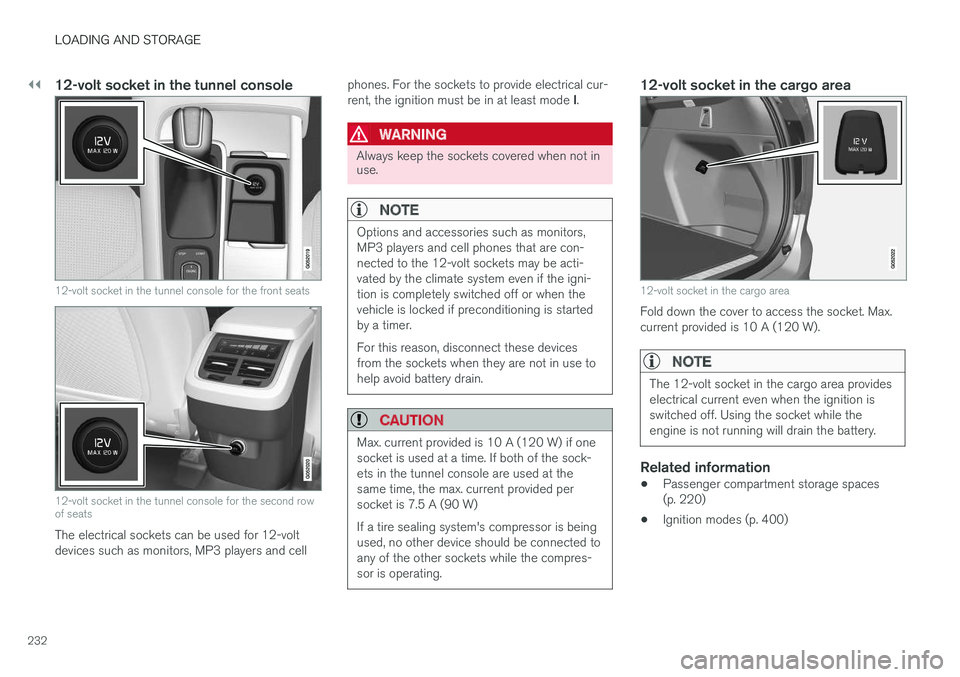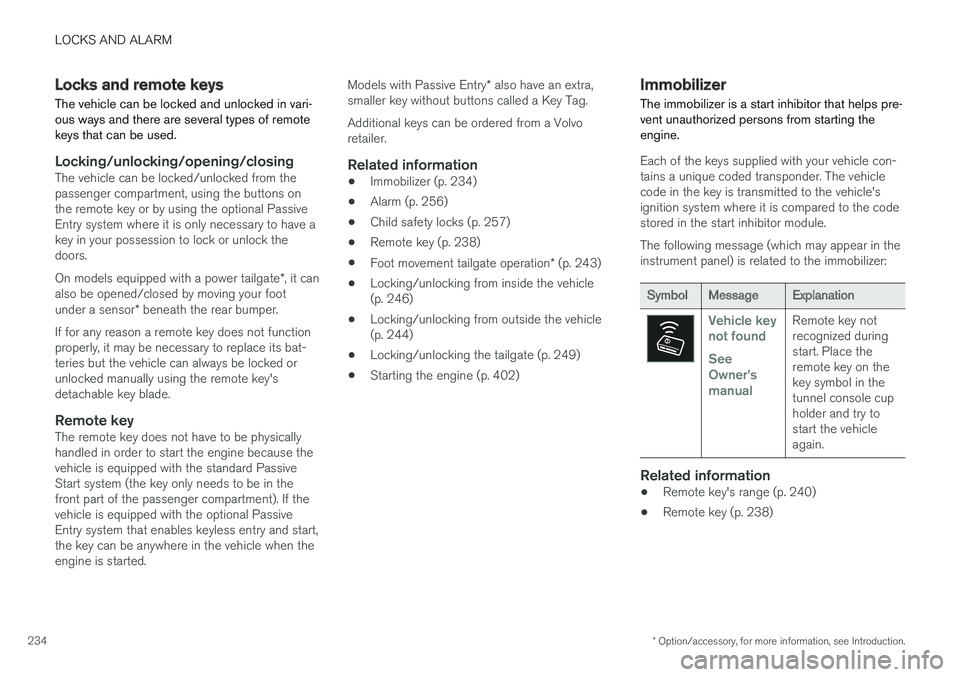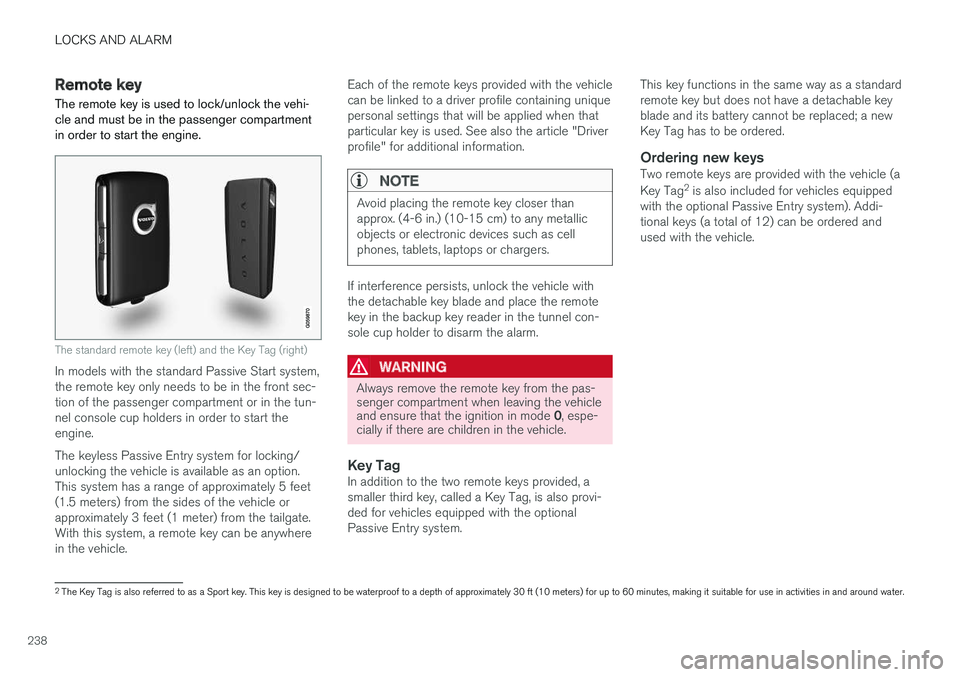VOLVO XC90 TWIN ENGINE HYBRID 2017 Owners Manual
Manufacturer: VOLVO, Model Year: 2017, Model line: XC90 TWIN ENGINE HYBRID, Model: VOLVO XC90 TWIN ENGINE HYBRID 2017Pages: 584, PDF Size: 14.2 MB
Page 231 of 584

LOADING AND STORAGE
229
Sun visors
There are vanity mirrors with card holders on theupper sides of the sun visors.
Lighted vanity mirror and card holder
The vanity mirror lighting comes on when the mir-ror is opened.
The vanity mirror's frame has a holder for e.g., acard or ticket.
Related information
•Passenger compartment storage spaces(p. 220)
Page 232 of 584

LOADING AND STORAGE
* Option/accessory, for more information, see Introduction.230
Electrical sockets
There are two 12-volt sockets in the tunnel con-sole, a 120-volt socket on the rear side of thetunnel console, and one 12-volt socket in thecargo area*.
120-volt socket in the tunnel console 3
120-volt socket in the tunnel console for the secondrow of seats
This socket is intended for 120-volt devices suchas laptops, chargers, etc.
The max. current provided is 150W.
Using the sockets
1. Remove or pull down the cover over thesocket and plug in the device.
> The socket's indicator light will indicate itsstatus. The socket can only provide elec-trical current when the light is green.
2. Disconnect the device by pulling its plug, notits cord.
Pull up the cover over the socket when it is not inuse.
CAUTION
•Do not connect devices with large orheavy plugs that could come loose whiledriving.
•Do not use devices that can cause inter-ference with the vehicle's radio receiveror electrical system.
WARNING
•Be sure to place any devices connectedto the socket safely so that they do notbecome projectiles in the event of a sud-den stop and injure the occupants of thevehicle.
•Be aware that connected devices maygenerate heat and become very hot.
•Only connect devices that function cor-rectly and are free from defects. Thesedevices should be intended for use in a120-volt, 60Hz socket with a plugintended for the socket in the vehicle andbe UL-approved (or the equivalentthereof).
•Never let the device, its plug or thesocket itself come in contact with fluidsof any kind. Never touch or use thesocket if it appears to be damaged orwet.
•Never connect multiple plugs, adapters orextension cords to the socket. This couldoverride the socket's safety functions.
•Never let children play or tamper with thesocket, or attempt to insert any objectsinto it. Never leave children unattended inthe vehicle when the socket is active.
•Never try to modify or repair the 120-voltsocket. This should only be done by a
3
Certain models only.
Page 233 of 584

LOADING AND STORAGE
}}
231
trained and qualified Volvo service techni-cian.
Failure to follow the points above could resultin electrical shock and/or serious injury.
Status indication
An LED (Light Emitting Diode) on the socketindicates its status:
Status indicator lightSocket statusAction
Steady green lightThe socket is providing current to a connected device.None.
Flashing orange lightThe socket's voltage converter is too hot (the connected device draws too muchcurrent, etc. or the temperature in the passenger compartment is very high).Unplug the device, let the converter cool downand plug in the device again.
The connected device draws too much current (constantly or currently) or is notfunctioning properly.None. The device should not be plugged into thesocket.
Indicator light offThe socket has not detected a plugged in device.Be sure the device is correctly plugged into thesocket.
The socket is not active.Put the vehicle's ignition in at least mode I.
The socket has been active but has been deactivated.Start the engine and/or charge the start battery.
If a problem persists, have the socket checked bya trained and qualified Volvo service technician.
Page 234 of 584

||
LOADING AND STORAGE
232
12-volt socket in the tunnel console
12-volt socket in the tunnel console for the front seats
12-volt socket in the tunnel console for the second rowof seats
The electrical sockets can be used for 12-voltdevices such as monitors, MP3 players and cell
phones. For the sockets to provide electrical cur-rent, the ignition must be in at least mode I.
WARNING
Always keep the sockets covered when not inuse.
NOTE
Options and accessories such as monitors,MP3 players and cell phones that are con-nected to the 12-volt sockets may be acti-vated by the climate system even if the igni-tion is completely switched off or when thevehicle is locked if preconditioning is startedby a timer.
For this reason, disconnect these devicesfrom the sockets when they are not in use tohelp avoid battery drain.
CAUTION
Max. current provided is 10 A (120 W) if onesocket is used at a time. If both of the sock-ets in the tunnel console are used at thesame time, the max. current provided persocket is 7.5 A (90 W)
If a tire sealing system's compressor is beingused, no other device should be connected toany of the other sockets while the compres-sor is operating.
12-volt socket in the cargo area
12-volt socket in the cargo area
Fold down the cover to access the socket. Max.current provided is 10 A (120 W).
NOTE
The 12-volt socket in the cargo area provideselectrical current even when the ignition isswitched off. Using the socket while theengine is not running will drain the battery.
Related information
•Passenger compartment storage spaces(p. 220)
•Ignition modes (p. 400)
Page 235 of 584

L O C K S A N D A L A R M
Page 236 of 584

LOCKS AND ALARM
* Option/accessory, for more information, see Introduction.234
Locks and remote keys
The vehicle can be locked and unlocked in vari-ous ways and there are several types of remotekeys that can be used.
Locking/unlocking/opening/closing
The vehicle can be locked/unlocked from thepassenger compartment, using the buttons onthe remote key or by using the optional PassiveEntry system where it is only necessary to have akey in your possession to lock or unlock thedoors.
On models equipped with a power tailgate*, it canalso be opened/closed by moving your footunder a sensor* beneath the rear bumper.
If for any reason a remote key does not functionproperly, it may be necessary to replace its bat-teries but the vehicle can always be locked orunlocked manually using the remote key'sdetachable key blade.
Remote key
The remote key does not have to be physicallyhandled in order to start the engine because thevehicle is equipped with the standard PassiveStart system (the key only needs to be in thefront part of the passenger compartment). If thevehicle is equipped with the optional PassiveEntry system that enables keyless entry and start,the key can be anywhere in the vehicle when theengine is started.
Models with Passive Entry* also have an extra,smaller key without buttons called a Key Tag.
Additional keys can be ordered from a Volvoretailer.
Related information
•Immobilizer (p. 234)
•Alarm (p. 256)
•Child safety locks (p. 257)
•Remote key (p. 238)
•Foot movement tailgate operation* (p. 243)
•Locking/unlocking from inside the vehicle(p. 246)
•Locking/unlocking from outside the vehicle(p. 244)
•Locking/unlocking the tailgate (p. 249)
•Starting the engine (p. 402)
Immobilizer
The immobilizer is a start inhibitor that helps pre-vent unauthorized persons from starting theengine.
Each of the keys supplied with your vehicle con-tains a unique coded transponder. The vehiclecode in the key is transmitted to the vehicle'signition system where it is compared to the codestored in the start inhibitor module.
The following message (which may appear in theinstrument panel) is related to the immobilizer:
SymbolMessageExplanation
Vehicle keynot found
SeeOwner'smanual
Remote key notrecognized duringstart. Place theremote key on thekey symbol in thetunnel console cupholder and try tostart the vehicleagain.
Related information
•Remote key's range (p. 240)
•Remote key (p. 238)
Page 237 of 584

LOCKS AND ALARM
}}
235
Changing the remote key's battery
The remote key can be opened if the batteryneeds to be replaced.
The battery should be replaced if:
•The information symbol illuminates andUnavailable Charge level too low isshown in the display
and/or
•if the locks do not react after severalattempts to unlock or lock the vehicle
Replacing the battery
Hold the remote key with the front side(with the Volvo symbol) toward you and movethe button on lower edge of the key near thekey ring to the right. Slide the front coverslightly upward.
The cover will loosen and can beremoved from the key.
Move the button to the side and sliderear cover slightly upward.
The cover will loosen and can beremoved from the key.
Page 238 of 584

||
LOCKS AND ALARM
236
Use e.g., a screwdriver to turn the batterycover counterclockwise so that the markersalign toward OPEN.
Remove the cover carefully by pressinge.g., a finger nail into the indentation.
Pry the cover up.
The battery's positive (+) side is up. Pryout the battery as shown in the illustration.
CAUTION
When handling batteries, avoid touching theircontact surfaces as this could result in poorbattery function in the remote key.
Insert a new battery1 with the positive (+)side up. Put the battery cover back in placeby:
Placing the battery's edge downward inthe holder. Slide the battery forward so that itis held in place by the two plastic catches.
Pressing the battery downward so that itis also held in place by the two uppercatches under the upper black holder.
and turn until the marker points to CLOSE.
1Use a CR2032, 3 V battery.
Page 239 of 584

LOCKS AND ALARM
237
NOTE
Volvo recommends that the batteries used inthe remote control meet the UN Manual ofTest and Criteria, Part III, sub-section 38.3.
Batteries installed in the key from the factoryand batteries exchanged by an authorizedVolvo workshop fulfill the above criteria.
Old batteries should be disposed of properlyat a recycling center or at your Volvo retailer.
Put the battery cover in place and turn itclockwise until the marker points to CLOSE.
Put the rear cover in position and pressdown until it clicks into place.
Slide the cover into place as indicated byarrow 2 in the illustration.
>Another click indicates that it is correctlyin position and closed.
Turn the key over and press the frontcover (with the Volvo logo) until it clicks intoplace.
Slide the cover into position as indicatedby arrow 2 in the illustration.
>Another click indicates that it is correctlyin position and closed.
Dispose of old batteries properly, preferably atrecycling station.
Related information
•Remote key (p. 238)
Page 240 of 584

LOCKS AND ALARM
238
Remote key
The remote key is used to lock/unlock the vehi-cle and must be in the passenger compartmentin order to start the engine.
The standard remote key (left) and the Key Tag (right)
In models with the standard Passive Start system,the remote key only needs to be in the front sec-tion of the passenger compartment or in the tun-nel console cup holders in order to start theengine.
The keyless Passive Entry system for locking/unlocking the vehicle is available as an option.This system has a range of approximately 5 feet(1.5 meters) from the sides of the vehicle orapproximately 3 feet (1 meter) from the tailgate.With this system, a remote key can be anywherein the vehicle.
Each of the remote keys provided with the vehiclecan be linked to a driver profile containing uniquepersonal settings that will be applied when thatparticular key is used. See also the article "Driverprofile" for additional information.
NOTE
Avoid placing the remote key closer thanapprox. (4-6 in.) (10-15 cm) to any metallicobjects or electronic devices such as cellphones, tablets, laptops or chargers.
If interference persists, unlock the vehicle withthe detachable key blade and place the remotekey in the backup key reader in the tunnel con-sole cup holder to disarm the alarm.
WARNING
Always remove the remote key from the pas-senger compartment when leaving the vehicleand ensure that the ignition in mode 0, espe-cially if there are children in the vehicle.
Key Tag
In addition to the two remote keys provided, asmaller third key, called a Key Tag, is also provi-ded for vehicles equipped with the optionalPassive Entry system.
This key functions in the same way as a standardremote key but does not have a detachable keyblade and its battery cannot be replaced; a newKey Tag has to be ordered.
Ordering new keys
Two remote keys are provided with the vehicle (a
Key Tag2 is also included for vehicles equippedwith the optional Passive Entry system). Addi-tional keys (a total of 12) can be ordered andused with the vehicle.
2The Key Tag is also referred to as a Sport key. This key is designed to be waterproof to a depth of approximately 30 ft (10 meters) for up to 60 minutes, making it suitable for use in activities in and around water.